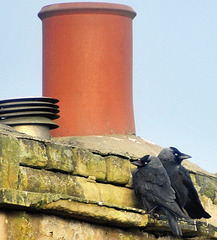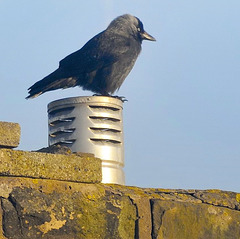Phil's photos with the keyword: Jackdaw
Fast food.
| 14 May 2019 |
|
|
|
A jackdaw carrying what appears to be a slice of brown bread back to it's nest on nearby buildings. The bird was about 30 metres / 33 yards from my shooting position according to the EXIF information so I had to crop the photo quite a lot to get a reasonably large image with my 200mm lens, therefore the resolution is not quite perfect. I used "continuous high speed" (10 frames per second) shooting mode and "continuous auto-focus" with an exposure compensation of +1.7 to avoid the bird becoming a silhouette against the bright blue sky.
Camera: Nikon D500
Lens: AF-S Nikkor 70-200mm f/2.8G ED VR II
Software: Nikon Capture NX2
Jackdaw in flight.
| 29 Apr 2019 |
|
|
|
The western jackdaw (Coloeus monedula), also known as the Eurasian jackdaw, European jackdaw, or simply jackdaw is a passerine bird in the crow family. Found across Europe, western Asia and North Africa it is mostly resident, although northern and eastern populations migrate south in winter. Four subspecies are recognised which mainly differ in the colouration of the plumage on the head and nape. Linnaeus first described it formally giving it the name Corvus monedula. The common name derives from the word jack, denoting "small", and daw, a less common synonym for "jackdaw" and the native English name for the bird.
Measuring 34–39 centimetres (13–15 in) in length the western jackdaw is a black-plumaged bird with a grey nape and distinctive pale-grey irises. It is gregarious and vocal, living in small groups with a complex social structure in farmland, open woodland, on coastal cliffs and in urban settings. Like its relatives, Jackdaws are intelligent birds and have been observed using tools. An omnivorous and opportunistic feeder, it eats a wide variety of plant material and invertebrates as well as food waste from urban areas. Western jackdaws are monogamous and build simple nests of sticks in cavities in trees, cliffs, or buildings.
(Wikipedia).
Camera: Nikon D300s
Lens: AF-S Nikkor 70-200mm f/2.8G ED VR II
Jackdaws (Coloeus monedula).
| 01 Nov 2017 |
|
|
|
The western jackdaw (Coloeus monedula), also known as the Eurasian jackdaw, European jackdaw, or simply jackdaw, is a passerine bird in the crow family. Found across Europe, western Asia and North Africa, it is mostly resident, although northern and eastern populations migrate south in winter. Four subspecies are recognised, which mainly differ in the colouration of the plumage on the head and nape. Linnaeus first described it formally, giving it the name Corvus monedula. The common name derives from the word "jack", meaning "small", and "daw", the native English name for the bird.
(Wikipedia).
Camera: Nikon D300s
Lens: AF-S VR Zoom-Nikkor 70-300mm f/4.5-5.6G IF-ED
Tough guy.
| 08 Jul 2017 |
|
|
|
A tough-looking jackdaw, photographed with a high ISO setting so it's not the best quality. That football chant (well-known to British viewers) springs to mind........."come and 'ave a go if you think you're 'ard enough" :-)
Camera: Nikon D300s
Lens: AF-S VR Zoom-Nikkor 70-300mm f/4.5-5.6G IF-ED
Processed with Nikon Capture NX2
Jackdaw (Corvus monedula).
| 06 Jul 2017 |
|
|
|
The western jackdaw (Corvus monedula), also known as the Eurasian jackdaw, European jackdaw, or simply jackdaw, is a passerine bird in the crow family. Found across Europe, western Asia and North Africa, it is mostly resident although northern and eastern populations migrate south in winter. Four subspecies are recognised which mainly differ in the colouration of the plumage on the head and nape. Linnaeus first described it formally giving it the name Corvus monedula. The common name derives from the word "jack" meaning "small" and "daw", the native English name for the bird.
Measuring 34–39 centimetres (13–15 in) in length, the western jackdaw is a black-plumaged bird with a grey nape and distinctive pale-grey irises. It is gregarious and vocal, living in small groups with a complex social structure in farmland, open woodland, on coastal cliffs and in urban settings. Like its relatives, Jackdaws are intelligent birds and have been observed using tools. An omnivorous and opportunistic feeder, it eats a wide variety of plant material and invertebrates as well as food waste from urban areas. Western jackdaws are monogamous and build simple nests of sticks in cavities in trees, cliffs, or buildings. About five pale blue or blue-green eggs with brown speckles are laid and incubated by the female. The young fledge in four to five weeks.
(Wikipedia).
Camera: Nikon D300s
Lens: AF-S VR Zoom-Nikkor 70-300mm f/4.5-5.6G IF-ED
Processed with Nikon Capture NX2
Jackdaw at sunset.
| 24 May 2013 |
|
|
|
Photographed in Brierfield in the North-West of England using a Nikon D90 camera and a AF-S Nikkor 70-200mm f/2.8G ED VR II lens.
Are we there yet ?
| 02 Jul 2013 |
|
|
|
Two Jackdaws, photographed using a Nikon D300s & Nikkor 70-200mm f2.8 lens in "continuous high-speed" mode (7fps). Background effect from PicMonkey. The idea for the title came from the expression on the top bird's face....a question which will be familiar to anyone who has ever travelled with young children :-)
Peek-A-Boo Jackdaws
| 01 Jun 2013 |
|
|
|
Jackdaws in Brierfield, UK. Camera: Nikon D300s. Lens: Nikkor 70-300mm.
www.ipernity.com/group/england
Jump to top
RSS feed- Phil's latest photos with "Jackdaw" - Photos
- ipernity © 2007-2025
- Help & Contact
|
Club news
|
About ipernity
|
History |
ipernity Club & Prices |
Guide of good conduct
Donate | Group guidelines | Privacy policy | Terms of use | Statutes | In memoria -
Facebook
Twitter








